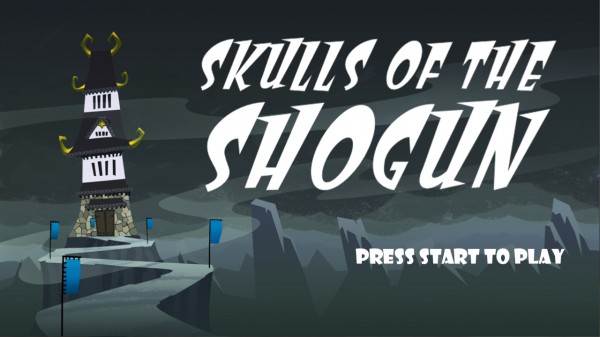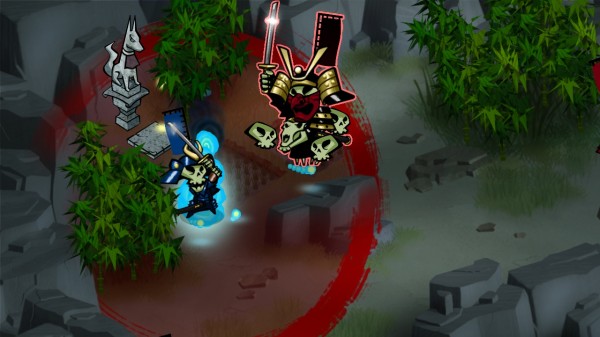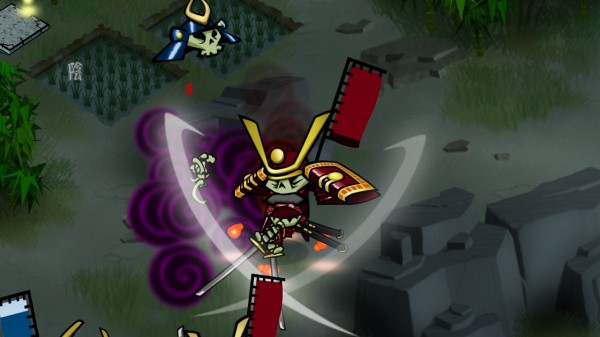Redefining a Genre: Skulls of the Shogun Aims to Add Accessibility; Keep Depth
The following article is based around an email interview conducted by our team with Jake Kazdal, CEO of Haunted Temple Studios. For the uninitiated, Haunted Temple Studios is currently developing Skulls of the Shogun for Xbox Live Arcade for Spring 2011 release.
Skulls of the Shogun is a turn based strategy title. Players take on the role of a Samurai General who was betrayed by one of his closest allies and slain in the moment of his greatest victory. Awakened in the afterlife, he finds the same opponent has betrayed him again in death. As a result, he begins a rampage trashing the laws of the Samurai afterlife as he seeks revenge.
Redefining a genre for accessibility
The four man team behind Haunted Temple Studios has over 34 years of experience, but that doesn’t mean they aren’t full of fresh ideas. Skulls of the Shogun is a fusion of these creative minds in an unbridled indie atmosphere. When development on Skulls of the Shogun began, the team knew they wanted to do something different. The gaming industry is constantly evolving, and they wanted to be on the forefront. Taking cues from one of the strategy genres most stalwart franchises, Haunted Temple Studios looks to add accessibility and a little Japanese flair in effort to completely redefine the genre. Jake Kazdal explained it like this:
I’ve always loved Advance Wars. That series is in my top 3 for sure. I’ve seen other genre’s getting cool upgrades lately in the gaming world and realized that although there are other new turn based games lately, no one is really reinventing the genre, so it was something I wanted to dive into and see what we could make. It’s obviously very influenced by my time spent living in Japan and my love of pop urban culture and character design as well. As development progressed and I realized we had the opportunity to completely reinvent our control scheme, I realized how many similar games have very obtuse unnecessarily complex control schemes and made it a deliberate decision to really try to make the game as accessible and easy to get into as possible for people who might think the game looks interesting but don’t have the patience of the traditional PC strategy-gamer.
One way the team has gone about fostering accessibility was to completely revamp game movement. Typically past strategy games have featured a grid system, similar to what one would see on a chess board. Player movements are restricted by these grids, as they must follow a path that may not exactly seem to make sense at times. Skulls of the Shogun instead chose to go with radial movement, where players can move anywhere within a certain radius as they traverse through the map. Jake explained the reasoning behind this.
Grid based is slow and clunky and feels intimidating to those not used to it. We are trying to create a new sub-genre of “Action-Strategy” where the game almost looks and feels like an action game, almost no menus, many of the defining elements of turn based strategy have been either replaced or removed, and a very lively dynamic system has arisen in its place. We are very pleased with the progress!
Not originally intended as an Xbox Live Arcade Title
While in development, it is not unusual for a game to dramatically change. Sometimes the original vision becomes more refined and other times things become completely overhauled. With indie studios that produce digital games, we’ve noticed this often means a complete change in platforms as the concept becomes fleshed out and implemented. Skulls of the Shogun is just one example of this transition. Jake took us through a brief development timeline telling us how the game progressed from an iPhone title to an XBLA and PC game. Not to mention the potential of a PSN release down the road:
The game actually started as an iPhone game but the lead engineer Borut Pfeifer is a long-time Windows developer and was much more comfortable in that development environment. We had a simple engine and once he tried some of the XNA development tools he was quickly sold and talked me into making it for Xbox and PC instead! Since then we have decided we would like to bring it to PSN as well so are looking for a developer to partner up with to help with that.
It’s all about strategy
Skulls of the Shogun places a small army at players disposal. There are three main combat troops, three Monks with magic abilities and the General. Players will have to strategize how to best defeat the enemy general, while also attacking and defending neutral territories that provide resources. The team stressed to us that the game is fast paced and not about resource generation and sitting back and amassing a massive army. Players will need to learn how to use each troop type effectively to succeed. Jake gave us some quick advice:
The three basic combat types are the infantry, the toughest unit in the game, meant for frontline defense. The Cavalry can flank and act as a very efficient scout and attacks with a Naginata Spear. The Archers are the ranged units, deadly at a distance but useless in hand to hand combat. After these there are 3 Monks that join you in battle, a Fox Monk who is a healer and defender, a pyromaniac Fire Salamander, agent of destruction, and the Crow Monk, agent of Chaos and disruption. Lastly you have your General, the player character and the enemy you are trying to take out on the other side, who starts off with more health than anyone and the ability to hit twice per round, making him a formidable opponent. But if he falls in battle, its game over so you must use him wisely and protect him with everything you have.
Don’t fret over the limited amount of units at your disposal, as Haunted Temple has found a way to make player upgrades essential to the game. Each battle becomes essential to victory due to the skull mechanic in the game. When a unit falls in battle, they drop a skull. This skull can then be used to upgrade the victorious unit. Jake made it clear that it wouldn’t unbalance the game though:
Skulls are a huge component of the game, hence the name! By spending your action point by eating a fallen enemy skull, you gain more max HP and heal up as well. After eating 3 skulls, you “explode with darkness” and become a War Demon variant on each class. 7 Total unit types + 7 demon types! Each demon type has a special ability that we are tuning now. The thing is, even when powered up, you can still fall easily in the heat of battle, dropping the now neutral skulls that anyone can feast on and quickly turn the tide of battle. The game is very focuses on risk and reward, and the gameplay systems tend to favor games that have no clear victor until very near the end!
Level design is slightly under wraps at the moment, but we were told that the four main worlds focused around a Japanese Season. Each of these provides unique weather and challenges. The game also features a physics system where hitting an enemy could have additional consequences. We can’t wait to hear more about this in the future.
The game can obviously be played 1 v 1, but the game also allows for some interesting outcomes when other players come into the picture. Jake in particular mentioned four player FFA. When talking about that mode, he put it like this:
4 player is a blast, we are fine tuning a system of dynamic alliances, where if you and another player are getting trounced by one of the other players you can form a temporary alliance, sharing resources and powers, even able to heal each other. But at some point, there can be only one and you have to carefully decide when you will betray your new ally in your quest for absolute domination! Lots of laughs and swearing with this mode, tons of fun.
Accessibility doesn’t mean watered-down
One of the main things the team tried to do with Skulls of the Shogun was maintain a fast pace nature. Many strategy games place a deliberate focus and spend a substantial amount of time on resource generation. In Skulls of the Shogun this isn’t the focus. Haunted Temple Studios wants people who may not be a huge fan of the genre to still want to try this game.
All the depth you need is there, but it is much more of a skirmish than a full blown war. Most units could make it to the other side of the map in just a few turns if they were unchallenged. Most of the combat can be achieved with just one stick and the A button, once you are familiar with the simple systems, gameplay is much faster than almost any other turn-based strategy game I can think of, and it really feels almost like an action game. Instead of cutting to a separate scene for the fight, we quickly just zoom in, watch just a few seconds of action and then zoom back out, ready for your next move. A lot of people who usually would never play a strategy game are loving SotS, the response has been glowing so far, I think we’re on the right track!
[The length of an average match] REALLY depends on the players, for me and someone else who has played at least a few times, games are usually 10-20 minutes. But I’ve seen super conservative types circle each other and take longer. We have created an in-game timer clock per round which is right now optional, but it really helps up the pace if needed.
Jake had one last closing remark for our readers. I personally know I cannot wait to get some hands on with this game.
People who love strategy games love Skulls of the Shogun. People who don’t love strategy games are still loving Skulls of the Shogun. I would ask anyone on the fence to try it for yourself, and be prepared to be pleasantly surprised!






